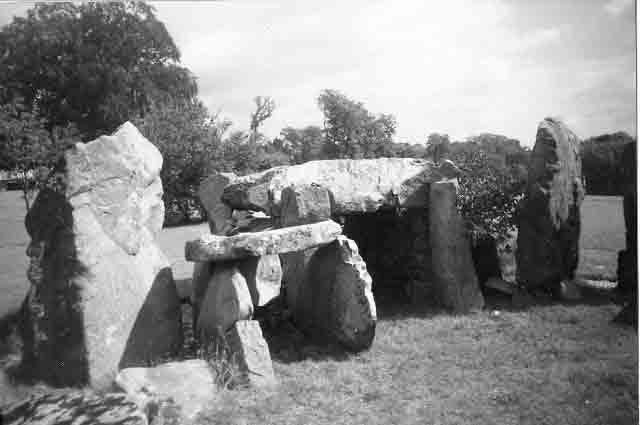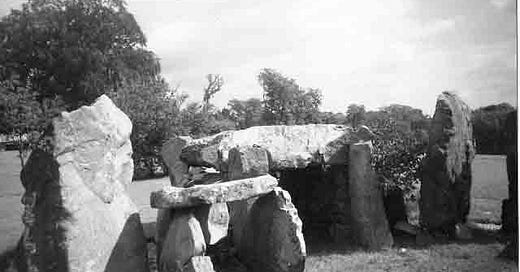Jersey is an Island of ghosts. I speak not of the men and women who have lived and died here over the tumultuous centuries, but of the great landmarks that have stood here and fallen. A few have left skeletons to remember them, like the mammoths of old. Think of the great fortress at Grosnez, whose broken carcass frames the western sunset.
Other landmarks have simply vanished into history, lingering only in sepia photographs. No living man remembers the caves of Five Oaks, the folly at La Hougue Bie, or our very own ‘Eiffel Tower’, the weather observatory at Maison St Louis. Yet long before all of these stood a more ancient monument still, set high on the Town Hill, watching over St Aubin’s Bay.
Jersey’s Stonehenge, they would call it, a ring of stones that must have endured thousands of winters and glimmered through countless summers. The wheel of history turned, empires rose and fell, and the blunt molars on the hill outlasted them all. The dolmen and their passage grave remained on the barren outcrop above St Helier, until they too were buried by time and age.

The Town Hill was a sacred place. When mysterious footprints were discovered, believed to be those of the Virgin Mary, the chapel of Notre Dame de Pas was built in her honour on its south-eastern flank. The Hill was a powerful vantage point, towering over the straggling huts of St Helier that gathered at its feet. In times of peace, the Seigneur of Samarès chased rabbits over its summit, and cattle grazed idly upon its bleak slopes. In times of war, its commanding views became a vital strategic asset.
The French invasion of 1781 – when the Battle of Jersey raged savagely in Royal Square - revealed the sheer inadequacy of Jersey’s defences. The time had finally come to tame the Town Hill and remodel it in the service of war. It would become Jersey’s Rock of Gibraltar, a stout stronghold, a British fortress. The Governor of Jersey, General Henry Seymour Conway, gave orders to scour the land, mapping it and moulding it, making plans for the work to come.
We meet him on a humid August morning in 1785, as sea-fog is rolling in from the south. The Colonel of the Militia is adamant; the drill field must be cleared today. His men would rather be downing cider in the taverns, but today they must level the land. They set to work with picks and shovels, sweat soon rising beneath their red militia jackets.
When the men start to break up a grassy mound, they strike hard rock. To their astonishment, this hillock is perched on granite stones, and they do not seem to have fallen here naturally. These sentinels have been painstakingly arranged; guardians left by a race of ancient men. A dark corridor opens into the earth, a passage grave leading into the darkness of a forgotten world.
The militiamen shrug. Mysterious barrows have long been part of the warp and weft of Jersey’s landscape, after all. Granite teeth glint across every parish; broken ceremonial stones have littered the hills since time immemorial. These new discoveries are mere obstacles to an evening of good cheer and ale. Yet suddenly a shiver runs through the camp; the Governor himself is approaching. The militiamen hastily smarten themselves, and assemble, and salute.
General Conway, an Old Etonian and self-appointed scion of the Enlightenment, sweeps into the field. He is utterly bewitched by the discovery. He peers into the darkness, running his hand over the cold stone that has been buried for so long. His antiquarian enthusiasms piqued, the General demands further and deeper excavations. The soldiers return to their labours.
And here they will unearth a perfect Stonehenge in miniature, a stone circle, the inheritance of a mysterious and inaccessible age. The crowning glory of Jersey’s Neolithic past was revealed. Standing in a seventy-two-foot circle, the granite monoliths were finally exposed to the fresh sunlight of an utterly different world.
Conway exulted in the discovery. It must be a Druid’s temple, he mused, a historically valuable relic of the wild time before the Romans subdued the world. The wily landowners of La Vingtaine shrugged at the General’s curiosity, his eccentric interest in a bundle of old stones. Yet they quickly spied a way to inveigle their way into his good favour. They would proffer him the stones as a gift of thanksgiving.
They beseeched “him to be so good as to accept the ancient monument which has been recently discovered on La Montagne de la Ville. They trust that His Excellency will not decline to accept this feeble but sincere tribute of their gratefulness". Legend has it that Conway was initially reluctant, fearing the cost of transit, but Horace Walpole, son of the first British Prime Minister, urged him to receive the gift. "Pray do not disappoint me but transport the Cathedral of your island to your domain on our continent."
Conway yielded; for the pile of rocks would make a most charming addition to his English country estate at Park Place. So, in 1788, the stones were felled from their hilltop, hauled onto ships; and they crossed the rough seas to a new island. Their old home was already dying; for in the decades to come, the Town Hill would be transformed into a mighty fortress. It would be given a new name, too: Fort Regent.
The old Town Hill was gone, fortified by the might of the British Army. The medieval Chapel of Notre Dame de Pas was blown up in 1814, its historic stones shredded, lest they provide shelter for an invading force. In time the Fort itself would become a relic, and was crowned by a graceful, mighty dome; until that too was threatened with demolition. The ancient Town Hill was forgotten.
The circle, however, endured. Near the banks of the meandering Thames, the dolmen was reassembled and embellished. The red granite stones that once towered over the tides of Jersey, and the drowned coast of St Clement, found a strange afterlife in the gentle folds of an Oxfordshire country estate.
The stones stand there to this day; lost fragments of Jersey; a scattering of wild red granite nestled in an English country garden. The sea still sings in their landlocked veins.
The centuries have slipped by like sand. The stones wait in silence, far from the barren hill, far from the place they knew before. Some say they will find their way home in time, and the lost stones of Jersey will return.
Paul Darroch is the author of Jersey: The Hidden Histories and Jersey: Secrets of the Sea.
(c) Paul Darroch 2024. Published by Open Page Learning Ltd, 9 Bond Street, St Helier, JE2 3NP. Registered in Jersey with company number 141338.




